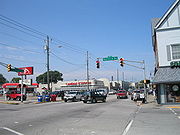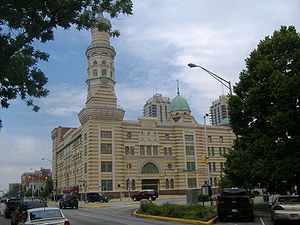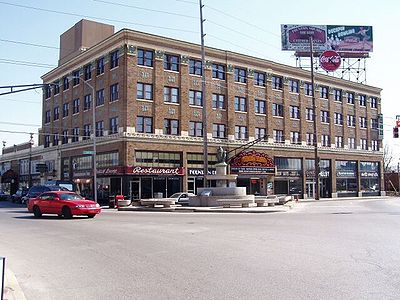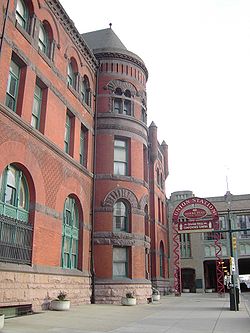
Indianapolis Cultural Districts
Encyclopedia
Indianapolis
has six designated neighborhoods as Cultural Districts: Broad Ripple Village
, Massachusetts Avenue
, Fountain Square
, the Wholesale District, the Canal & White River State Park
, and Indiana Avenue
.

Originally an independent municipality, Broad Ripple was annexed by Indianapolis in 1922.
It currently hosts an active social scene, fueled by the near presence of Butler University
. A large number of private art galleries, bars, and independently owned restaurants line the Village's streets. There are various venues for eating, entertainment and shopping. There are several restaurants that you can get a good variety of food such as Chinese, Indian, Thai. For entertainment, there is comedy, sports bars, and two brewpubs.
 Massachusetts Avenue offers some of the city's most visible theaters and art galleries. Located just a few blocks northeast of Monument Circle, Massachusetts Avenue was designed in 1821 as one of Downtown's four original diagonal streets and began as a commercial artery that mainly served the surrounding residential area. The Avenue gained popularity as service-oriented businesses sprung up with the development of streetcar lines. The Avenue grew continuously between 1870 and 1930.
Massachusetts Avenue offers some of the city's most visible theaters and art galleries. Located just a few blocks northeast of Monument Circle, Massachusetts Avenue was designed in 1821 as one of Downtown's four original diagonal streets and began as a commercial artery that mainly served the surrounding residential area. The Avenue gained popularity as service-oriented businesses sprung up with the development of streetcar lines. The Avenue grew continuously between 1870 and 1930.
Bernard Vonnegut, grandfather of author Kurt Vonnegut
, and Arthur Bohn designed the Athenaeum in 1893 as a home for German societies in Indianapolis to gather. Both were American-born sons of German immigrants, a culture that had a strong influence in the area around this time. Following these many years of good fortune and commercial growth, this area and all of Downtown fell into economic decline following World War II once Indianapolis lost its importance as a railroad hub.
Gentrification in the 1990s propelled the area from squalor to one of the city's more fashionable addresses. Currently, redevelopment of "Mass Ave" focuses on fostering locally-owned shops, theaters, and restaurants. The once destined-for-demolition Athenaeum building
now houses the American Cabaret Theatre, Rathskeller Restaurant
and downtown YMCA
location.
 Fountain Square is a neighborhood located approximately 1½ miles (2.4 km) southeast of downtown
Fountain Square is a neighborhood located approximately 1½ miles (2.4 km) southeast of downtown
and is centered at the intersection of Virginia Avenue and Shelby Street. A center of commerce for more than 100 years, the historic community is undergoing a period of rebirth and restoration, and is emerging as an ethnic and arts area for Indianapolis.
In the nineteenth century, the area was a huge working apple orchard. As the city population swelled, the apple trees were cut down and houses were built. The neighborhood was economically strong for many decades, but had suffered from a high unemployment rate and increasing crime and drug problems. In the 1970s, the state of Indiana
built the I-65 interstate through Indianapolis, severing Fountain Square from the city proper, resulting in a period of decline. There is an effort underway to reconfigure I-65 and I-70, which offers hope to many that Fountain Square will rejoin the downtown area. Currently, there are a number of neighborhood development corporations and community groups working to revitalize the area with increasing success.
 Around the turn of the century Downtown Indianapolis
Around the turn of the century Downtown Indianapolis
had one of the largest networks of railroads in the nation and hundreds of trains passed through Union Station
daily. Streets adjacent to the station were lined with businesses, hotels, warehouses, retail shops and more. Wholesale grocers sold fresh goods daily before the advent of the modern grocery store. The district had many such grocers, but also wholesalers who sold dry and finished goods. The House of Crane, whose facade remains part of Circle Centre, sold cigars; Hanson, VanCamp & Co. sold hardware. In addition, South Delaware Street became known as Commission Row, where farmers brought their produce to merchants who sold the goods for a commission fee. The Wholesale District was of primary importance in the transformation of Indianapolis from small town to big city. No longer did shoppers have to rely on retailers who sold finished goods shipped from Louisville or Cincinnati. They could now go to a central location and buy the same items at wholesale prices. With Union Station nearby, wholesalers could ship goods more cheaply and more easily. Unfortunately, the Great Depression devastated the area and few businesses remained.
Since 1995, more than $686 million has been invested in the area, transforming it into the city's premier arts and entertainment district. Recent additions include more than 35 new businesses, Circle Centre
, Conseco Fieldhouse
, Lucas Oil Stadium
, and a number of upscale restaurants. The area also includes the Hilbert Circle Theater, home of the Indianapolis Symphony Orchestra
, which recently underwent a 2.5 million dollar renovation.
located in Indianapolis was refurbished and re-opened as a city recreational area in the early 1990s. This new incarnation was inspired by Venetian canals. Cultural attractions were built along both sides of the Canal after its transformation. The north end of the Canal is now home to a burgeoning commercial life science initiative, anchored by a state-certified technology park. An extension of the Canal into the heart of the growing White River State Park was completed in 1996. The extension was part of a $20 million infrastructure improvement project that included renovation of the Old Washington Street
Bridge, built in 1916 as part of the National Road
, into a pedestrian crossing that links park attractions.
is also located in the heart of the district.
The Avenue continued to develop culturally after the turn of the century in much the same way as the Harlem Renaissance
. Many prominent historical figures have their roots on Indiana Avenue: Madam C.J. Walker, jazz greats including Freddie Hubbard
, Jimmy Coe
, Noble Sissle
, Erroll "Groundhog" Grandy and Wes Montgomery
. Mary Ellen Cable was one of the most important African-American educators in Indianapolis. She also organized and was the first president of Indiana's first NAACP chapter. As the Great Migration
brought African-Americans to Indianapolis by the thousands, Indiana Avenue continued to flourish into the 1930s, despite the woes of the Great Depression
.
However, by the late 1950s, the African-American middle class had begun to leave Indiana Avenue for northwestern Marion County, settling in Pike and Washington townships. The Walker Manufacturing Company remained in operation in the Walker Building in 1965, but the majority of the building was shut down removing a vital economic anchor for the area. By the early 1970s, Indiana Avenue was suffering from severe urban blight. By the 1980s, instead of the city attempting renewal or regeneration, much of the area was merely demolished and replaced by office buildings or townhouses, although the Walker Building and theater were restored and reopened to the public. While no longer a blighted zone, Indiana Avenue's legacy now consists only of a few historic buildings and a plaque. Plans are under way for the regeneration of the area.
Indianapolis
Indianapolis is the capital of the U.S. state of Indiana, and the county seat of Marion County, Indiana. As of the 2010 United States Census, the city's population is 839,489. It is by far Indiana's largest city and, as of the 2010 U.S...
has six designated neighborhoods as Cultural Districts: Broad Ripple Village
Broad Ripple Village, Indianapolis
Broad Ripple Village is one of six areas designated as cultural districts in Indianapolis, Indiana. Located about six miles north of Downtown Indianapolis, Broad Ripple was established in 1837 as an independent municipality and annexed to the city of Indianapolis in 1922...
, Massachusetts Avenue
Massachusetts Avenue, Indianapolis
Massachusetts Avenue, or simply "Mass Ave", is one of six designated cultural districts in Indianapolis, Indiana. It is located just a few blocks northeast of Monument Circle. Massachusetts Avenue was one of the four original diagonal streets of downtown Indianapolis in Alexander Ralston's plan of...
, Fountain Square
Fountain Square, Indianapolis
Fountain Square is one of six designated cultural districts in Indianapolis, Indiana.-History:In 1835, Calvin Fletcher and Nicholas McCarty purchased a farm in what would became the Fountain Square neighborhood. Although the earliest settlement was sparse and primarily residential, substantial...
, the Wholesale District, the Canal & White River State Park
White River State Park
White River State ParkDesignationState ParkLocationIndianapolis, Indiana USANearest CityIndianapolis, IndianaArea Date of Establishment1979Governing Body...
, and Indiana Avenue
Indiana Avenue
Indiana Avenue is a historic area in downtown and is one of six designated cultural districts in Indianapolis, Indiana. Indiana Avenue was, during its glory days, an African American cultural center of the area....
.
Broad Ripple Village

Originally an independent municipality, Broad Ripple was annexed by Indianapolis in 1922.
It currently hosts an active social scene, fueled by the near presence of Butler University
Butler University
Butler University is a private university located in Indianapolis, Indiana. Founded in 1855 and named after founder Ovid Butler, the university offers 60 degree programs to 4,400 students through six colleges: business, communication, education, liberal Arts and sciences, pharmacy and health...
. A large number of private art galleries, bars, and independently owned restaurants line the Village's streets. There are various venues for eating, entertainment and shopping. There are several restaurants that you can get a good variety of food such as Chinese, Indian, Thai. For entertainment, there is comedy, sports bars, and two brewpubs.
Massachusetts Avenue

Bernard Vonnegut, grandfather of author Kurt Vonnegut
Kurt Vonnegut
Kurt Vonnegut, Jr. was a 20th century American writer. His works such as Cat's Cradle , Slaughterhouse-Five and Breakfast of Champions blend satire, gallows humor and science fiction. He was known for his humanist beliefs and was honorary president of the American Humanist Association.-Early...
, and Arthur Bohn designed the Athenaeum in 1893 as a home for German societies in Indianapolis to gather. Both were American-born sons of German immigrants, a culture that had a strong influence in the area around this time. Following these many years of good fortune and commercial growth, this area and all of Downtown fell into economic decline following World War II once Indianapolis lost its importance as a railroad hub.
Gentrification in the 1990s propelled the area from squalor to one of the city's more fashionable addresses. Currently, redevelopment of "Mass Ave" focuses on fostering locally-owned shops, theaters, and restaurants. The once destined-for-demolition Athenaeum building
Athenæum (Das Deutsche Haus)
The Athenæum, originally named Das Deutsche Haus , is the most ornate and best-preserved building affiliated with the German American community of Indianapolis. Once used as a German American turnverein and clubhouse, it currently houses many groups, organizations, and businesses...
now houses the American Cabaret Theatre, Rathskeller Restaurant
Rathskeller
Ratskeller is a name in German-speaking countries for a bar or restaurant located in the basement of a city hall or nearby...
and downtown YMCA
YMCA
The Young Men's Christian Association is a worldwide organization of more than 45 million members from 125 national federations affiliated through the World Alliance of YMCAs...
location.
Fountain Square

Downtown Indianapolis
The term Downtown Indianapolis refers to the central business district of Indianapolis, Indiana, USA. The boundaries of downtown Indianapolis have varied over time as the city has grown. The city's original platted area, the Mile Square, is sometimes used to denote the downtown area...
and is centered at the intersection of Virginia Avenue and Shelby Street. A center of commerce for more than 100 years, the historic community is undergoing a period of rebirth and restoration, and is emerging as an ethnic and arts area for Indianapolis.
In the nineteenth century, the area was a huge working apple orchard. As the city population swelled, the apple trees were cut down and houses were built. The neighborhood was economically strong for many decades, but had suffered from a high unemployment rate and increasing crime and drug problems. In the 1970s, the state of Indiana
Indiana
Indiana is a US state, admitted to the United States as the 19th on December 11, 1816. It is located in the Midwestern United States and Great Lakes Region. With 6,483,802 residents, the state is ranked 15th in population and 16th in population density. Indiana is ranked 38th in land area and is...
built the I-65 interstate through Indianapolis, severing Fountain Square from the city proper, resulting in a period of decline. There is an effort underway to reconfigure I-65 and I-70, which offers hope to many that Fountain Square will rejoin the downtown area. Currently, there are a number of neighborhood development corporations and community groups working to revitalize the area with increasing success.
Wholesale District

Downtown Indianapolis
The term Downtown Indianapolis refers to the central business district of Indianapolis, Indiana, USA. The boundaries of downtown Indianapolis have varied over time as the city has grown. The city's original platted area, the Mile Square, is sometimes used to denote the downtown area...
had one of the largest networks of railroads in the nation and hundreds of trains passed through Union Station
Union Station (Indianapolis)
The Indianapolis Union Station was the first union station in the world, opening on September 20, 1853, by the Indianapolis Union Railway within the Wholesale District of Indianapolis, Indiana at 39 Jackson Place...
daily. Streets adjacent to the station were lined with businesses, hotels, warehouses, retail shops and more. Wholesale grocers sold fresh goods daily before the advent of the modern grocery store. The district had many such grocers, but also wholesalers who sold dry and finished goods. The House of Crane, whose facade remains part of Circle Centre, sold cigars; Hanson, VanCamp & Co. sold hardware. In addition, South Delaware Street became known as Commission Row, where farmers brought their produce to merchants who sold the goods for a commission fee. The Wholesale District was of primary importance in the transformation of Indianapolis from small town to big city. No longer did shoppers have to rely on retailers who sold finished goods shipped from Louisville or Cincinnati. They could now go to a central location and buy the same items at wholesale prices. With Union Station nearby, wholesalers could ship goods more cheaply and more easily. Unfortunately, the Great Depression devastated the area and few businesses remained.
Since 1995, more than $686 million has been invested in the area, transforming it into the city's premier arts and entertainment district. Recent additions include more than 35 new businesses, Circle Centre
Circle Centre
Circle Centre is a large indoor shopping mall located in downtown Indianapolis. Plans for a downtown Indianapolis mall had been in development by the Simon Property Group since 1979. Circle Centre was opened to the public on September 8, 1995, adjoining Simon corporate headquarters, and...
, Conseco Fieldhouse
Conseco Fieldhouse
Conseco Fieldhouse is a multi-purpose arena located in downtown Indianapolis, Indiana, United States. Opened in November 1999 to replace Market Square Arena, it is home to the Indiana Pacers of the National Basketball Association and the Indiana Fever of the Women's National Basketball Association...
, Lucas Oil Stadium
Lucas Oil Stadium
Lucas Oil Stadium is a multi-purpose sports stadium in Downtown Indianapolis, Indiana. The stadium celebrated its grand opening on August 24, 2008, and its ribbon-cutting ceremony August 16, 2008. It replaced the RCA Dome as the home field of the NFL's Indianapolis Colts. The stadium was built to...
, and a number of upscale restaurants. The area also includes the Hilbert Circle Theater, home of the Indianapolis Symphony Orchestra
Indianapolis Symphony Orchestra
The Indianapolis Symphony Orchestra is a major American orchestra based in Indianapolis, Indiana.Annually, the Indianapolis Symphony Orchestra performs 200 concerts for over 350,000 people. It is the largest performing arts organization in Indiana. The ISO is currently one of only 18 American...
, which recently underwent a 2.5 million dollar renovation.
Canal and White River State Park
The long defunct Indiana Central CanalIndiana Central Canal
The Indiana Central Canal was a canal intended to connect the Wabash and Erie Canal to the Ohio River. It was funded by the Mammoth Internal Improvement Act, Indiana's attempt to take part in the canal-building craze, started by the Erie Canal. $3.5 million was allocated for the project, the...
located in Indianapolis was refurbished and re-opened as a city recreational area in the early 1990s. This new incarnation was inspired by Venetian canals. Cultural attractions were built along both sides of the Canal after its transformation. The north end of the Canal is now home to a burgeoning commercial life science initiative, anchored by a state-certified technology park. An extension of the Canal into the heart of the growing White River State Park was completed in 1996. The extension was part of a $20 million infrastructure improvement project that included renovation of the Old Washington Street
Washington Street (Indianapolis)
Washington Street is the primary east-west street in Indianapolis, Indiana, United States. The street follows the route of the National Road for almost all of its length in the city of Indianapolis. For a time, its entire length was designated as U.S...
Bridge, built in 1916 as part of the National Road
National Road
The National Road or Cumberland Road was the first major improved highway in the United States to be built by the federal government. Construction began heading west in 1811 at Cumberland, Maryland, on the Potomac River. It crossed the Allegheny Mountains and southwestern Pennsylvania, reaching...
, into a pedestrian crossing that links park attractions.
Indiana Avenue
In 1870, more African-Americans were calling Indiana Avenue home as the original Irish and German populations began to move outward. The population had risen to 974 residents, more than one-third of the city's total African-American population. As the population escalated, African-American residents remained and opened more and more businesses. Bethel African Methodist Episcopal Church, the oldest African-American congregation in Indianapolis, was organized in 1836. The first African-American businesses appeared on the 500 Block of Indiana Avenue as early as 1865: Samuel G. Smother's grocery store; William Franklin's peddler shop and the city's first African-American-owned newspaper, The Indianapolis Leader in 1879. The Madame Walker Theatre CenterMadame Walker Theatre Center
The historic Madame C.J. Walker Building, which houses the Madame Walker Theatre Center, has long symbolized the spirit of creativity and community pride in the City of Indianapolis. Named after America’s first self-made female millionaire, Madam C.J. Walker, the site represents the achievements,...
is also located in the heart of the district.
The Avenue continued to develop culturally after the turn of the century in much the same way as the Harlem Renaissance
Harlem Renaissance
The Harlem Renaissance was a cultural movement that spanned the 1920s and 1930s. At the time, it was known as the "New Negro Movement", named after the 1925 anthology by Alain Locke...
. Many prominent historical figures have their roots on Indiana Avenue: Madam C.J. Walker, jazz greats including Freddie Hubbard
Freddie Hubbard
Frederick Dewayne "Freddie" Hubbard was an American jazz trumpeter. He was known primarily for playing in the bebop, hard bop and post bop styles from the early 1960s and on...
, Jimmy Coe
Jimmy Coe
James R. Coe was a jazz saxophonist.He first played in a band with Erroll "Groundhog" Grandy who mentored J. J. Johnson and Wes Montgomery...
, Noble Sissle
Noble Sissle
Noble Sissle was an American jazz composer, lyricist, bandleader, singer and playwright.-Early life:...
, Erroll "Groundhog" Grandy and Wes Montgomery
Wes Montgomery
John Leslie "Wes" Montgomery was an American jazz guitarist. He is widely considered one of the major jazz guitarists, emerging after such seminal figures as Django Reinhardt and Charlie Christian and influencing countless others, including Pat Martino, George Benson, Russell Malone, Emily...
. Mary Ellen Cable was one of the most important African-American educators in Indianapolis. She also organized and was the first president of Indiana's first NAACP chapter. As the Great Migration
Great Migration (African American)
The Great Migration was the movement of 6 million blacks out of the Southern United States to the Northeast, Midwest, and West from 1910 to 1970. Some historians differentiate between a Great Migration , numbering about 1.6 million migrants, and a Second Great Migration , in which 5 million or more...
brought African-Americans to Indianapolis by the thousands, Indiana Avenue continued to flourish into the 1930s, despite the woes of the Great Depression
Great Depression
The Great Depression was a severe worldwide economic depression in the decade preceding World War II. The timing of the Great Depression varied across nations, but in most countries it started in about 1929 and lasted until the late 1930s or early 1940s...
.
However, by the late 1950s, the African-American middle class had begun to leave Indiana Avenue for northwestern Marion County, settling in Pike and Washington townships. The Walker Manufacturing Company remained in operation in the Walker Building in 1965, but the majority of the building was shut down removing a vital economic anchor for the area. By the early 1970s, Indiana Avenue was suffering from severe urban blight. By the 1980s, instead of the city attempting renewal or regeneration, much of the area was merely demolished and replaced by office buildings or townhouses, although the Walker Building and theater were restored and reopened to the public. While no longer a blighted zone, Indiana Avenue's legacy now consists only of a few historic buildings and a plaque. Plans are under way for the regeneration of the area.

